Houses of Parliament
by Claude Monet
Fast Facts
- Year
- 1903
- Medium
- Oil on canvas
- Dimensions
- 81.3 × 92.5 cm
- Location
- National Gallery of Art, Washington
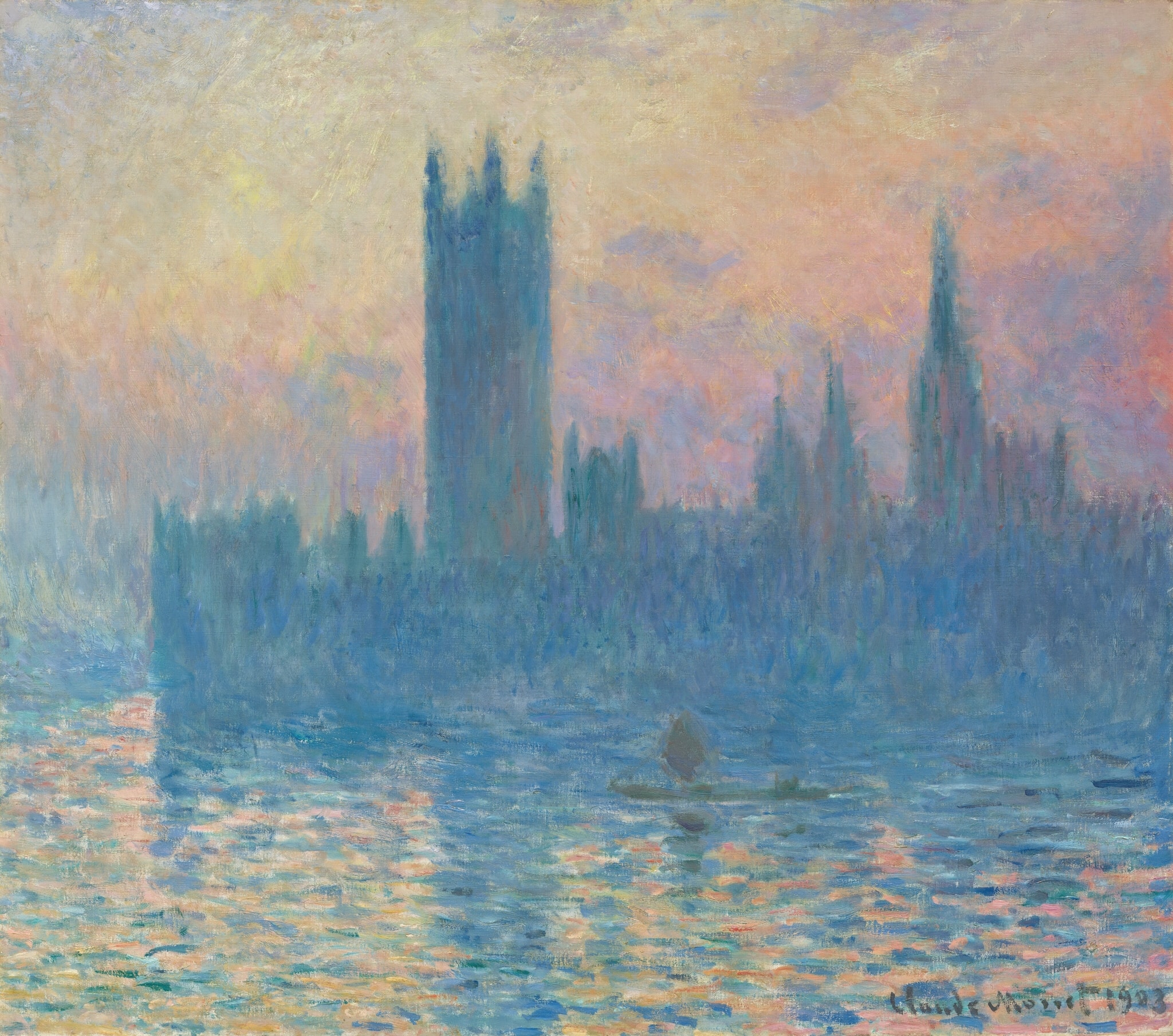
Click on any numbered symbol to learn more about its meaning
Meaning & Symbolism
The meaning of Houses of Parliament lies in its claim that power is perceived through light, not masonry: the Gothic mass becomes a transient envelope of color where authority is filtered by fog and time 13. It matters because Monet fuses poetic vision with empirical observation of London’s pollution‑tinted haze, transforming a national symbol into a modern study of perception and environment 145. By serially returning to this motif at sunset, he converts Westminster into a laboratory of change, proving that seeing is historical, atmospheric, and contingent 24.
Look at the canvas: Victoria Tower rises like a darkened cliff, but its edges blur into the surrounding air; spires to the right taper into a violet ether; and the Thames below breaks into rectangular flashes of pink, lemon, and icy blue. Monet’s touch is brief and granular, refusing contour in favor of a vibrating surface that binds sky and water into one chromatic field. This deliberate dematerialization is not decorative; it asserts that the institution’s meaning depends on the conditions of seeing. The seat of government becomes a tone—cool ultramarine—pressed against warm afterglow, while a single skiff floats at center, a fragile datum of human measure. In this balance, light acts as a democratizing force: it makes stone and water formally equivalent, converting political mass into atmospheric sensation 13. The peach‑mauve sky functions as a temporal metronome, registering the day’s decline; the river’s gridded reflections carry that time downward, so that history’s emblem is literally tethered to passing minutes. Monet’s choice of subject and method intensify this claim. Painting from the St Thomas’s Hospital terrace across the Thames, he aligned his canvas with the descending sun to catch the moment when fog and backlight reduce the building to silhouette. Scientific reconstructions of the series mark these aims with precision: the sun’s position and the haze’s optical effects—reduced contrast, whitening halos—map onto late‑Victorian coal smog, meaning the color chords we see are not only lyrical but also environmental data 45. In other words, the pink‑gold veils are modernity’s air made visible. By serially working multiple canvases and finishing many in Giverny, he turned Parliament into a variable he could recalibrate whenever light matched the remembered state; the picture thus encodes process as content, insisting that truth here is iterative and comparative, not singular 12. The painting also reframes symbolism. Gothic verticals usually project permanence, yet here they melt into suspended vapor. The work claims that power endures only as it is mediated by atmosphere—by weather, season, hour, and pollution—so that authority appears both monumental and provisional. The small boat intensifies this argument without anecdote: it is no narrative character, just a tonal knot whose low silhouette punctuates the river’s shimmer. Its scale makes the institution’s grandeur legible while implying that lived experience navigates, rather than mirrors, the state. Critically, this is not allegory imposed after the fact; museum records emphasize the series’ aim to dissolve architecture into color, while the optical science corroborates Monet’s observation of polluted light 1345. That synthesis—poetry anchored to measurable atmosphere—explains why Houses of Parliament is important: it advances Impressionism’s core wager that perception is history, and it anticipates Monet’s late Water Lilies by translating solid form into nearly abstract fields of chroma and flicker 23. In the end, the painting does not commemorate Westminster; it tests it—against fog, time, and the sun—showing that even the hardest stone becomes a temporary event on the surface of air and water.Citations
- National Gallery of Art: The Houses of Parliament, Sunset
- The Metropolitan Museum of Art: Houses of Parliament (Effect of Fog)
- Musée d’Orsay: Londres, le Parlement. Trouée de soleil dans le brouillard
- Royal Society (Baker & Thornes, 2006): Solar geometry and Monet’s London series
- PNAS (2023): Atmospheric pollution and the optics of Impressionist skies
- Art Institute of Chicago: Houses of Parliament, London
- Musée d’Orsay – Londres, le Parlement. Trouée de soleil dans le brouillard
- Baker & Thornes (2006), Solar position and Monet’s Houses of Parliament
- PNAS (2023), Impressionist skies as records of atmospheric pollution
- National Gallery of Art – The Houses of Parliament, Sunset
- The Metropolitan Museum of Art – The Houses of Parliament (Effect of Fog)
- Art Institute of Chicago – Houses of Parliament, London
- The Art Newspaper – Courtauld show to make Monet’s 1905 London ‘dream exhibition’ a reality
- Financial Times – Review of Monet’s London works
Explore Deeper with AI
Ask questions about Houses of Parliament
Popular questions:
Powered by AI • Get instant insights about this artwork
Interpretations
Historical Context
Source: Royal Society (Baker & Thornes, 2006); PNAS (2023)
Formal Analysis
Source: Musée d’Orsay; The Metropolitan Museum of Art; National Gallery of Art
Symbolic Reading
Source: Musée d’Orsay; Royal Society; PNAS
Social Commentary
Source: Royal Society; PNAS
Reception History
Source: The Art Newspaper; National Gallery of Art; Financial Times
Related Themes
About Claude Monet
More by Claude Monet

Haystacks Series by Claude Monet | Light, Time & Atmosphere
Claude Monet
Claude Monet’s <strong>Haystacks Series</strong> transforms a routine rural subject into an inquiry into <strong>light, time, and perception</strong>. In this sunset view, the stacks swell at the left while the sun burns through the gap, making the field shimmer with <strong>apricot, lilac, and blue</strong> vibrations.

The Artist's Garden at Giverny
Claude Monet (1900)
In The Artist's Garden at Giverny, Claude Monet turns his cultivated Clos Normand into a field of living color, where bands of violet <strong>irises</strong> surge toward a narrow, rose‑colored path. Broken, flickering strokes let greens, purples, and pinks mix optically so that light seems to tremble across the scene, while lilac‑toned tree trunks rhythmically guide the gaze inward <sup>[1]</sup><sup>[3]</sup>.
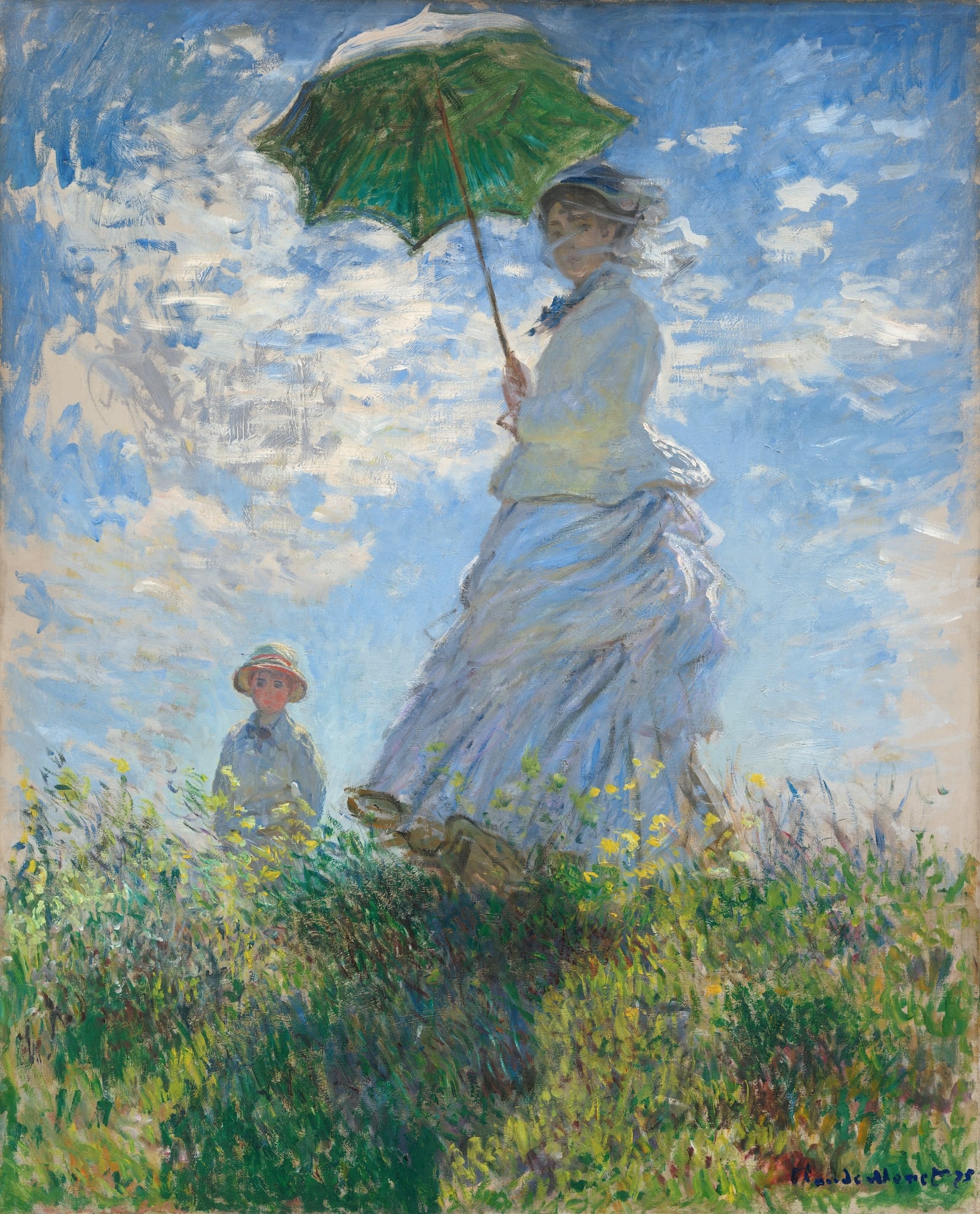
Woman with a Parasol
Claude Monet (1875)
Claude Monet’s Woman with a Parasol fixes a breezy hillside instant in high, shifting light, setting a figure beneath a <strong>green parasol</strong> against a vast, vibrating sky. The low vantage and <strong>broken brushwork</strong> merge dress, clouds, and grasses into one atmosphere, while a child at the rise anchors depth and intimacy <sup>[1]</sup>. It is a manifesto of <strong>plein-air</strong> perception—painting the sensation of air in motion rather than the contours of things <sup>[2]</sup>.
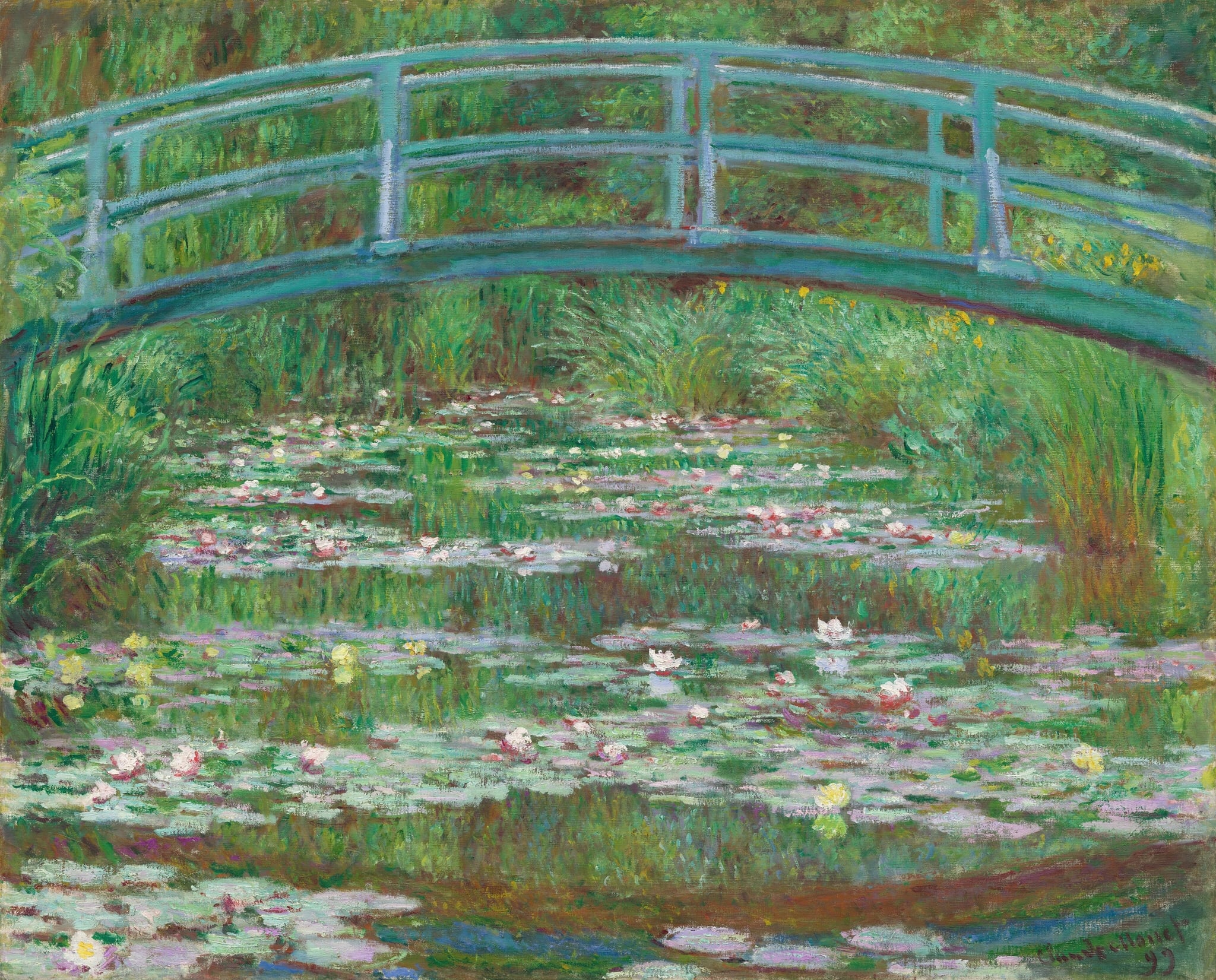
The Japanese Footbridge
Claude Monet (1899)
Claude Monet’s The Japanese Footbridge turns his Giverny garden into an <strong>immersive field of perception</strong>: a pale blue-green arc spans water crowded with lilies, while grasses and willows dissolve into vibrating greens. By eliminating the sky and anchoring the scene with the bridge, Monet makes <strong>reflection, passage, and time</strong> the picture’s true subjects <sup>[1]</sup><sup>[2]</sup>.
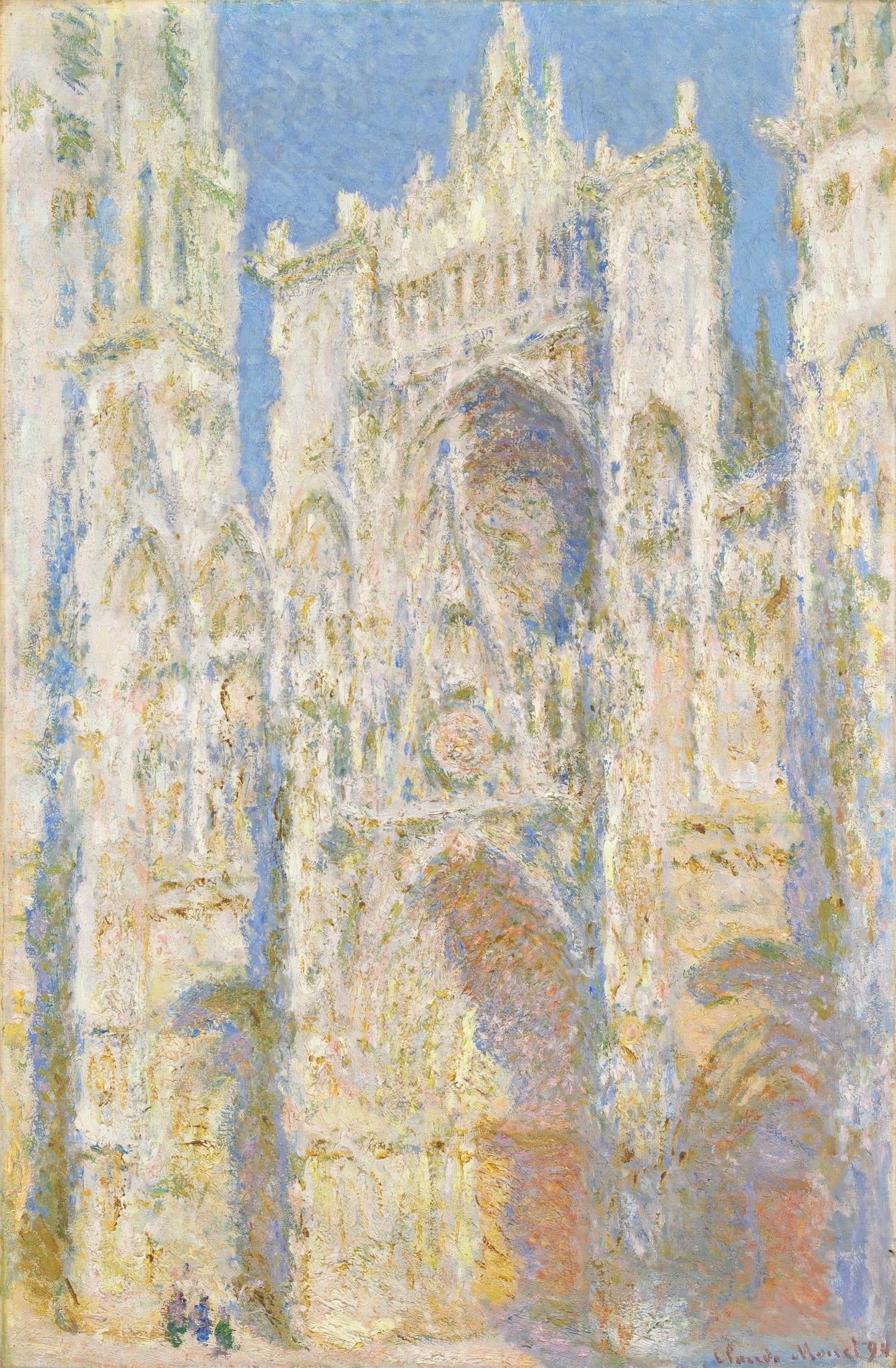
Rouen Cathedral Series
Claude Monet (1894)
Claude Monet’s Rouen Cathedral Series (1892–94) turns a Gothic monument into a laboratory of <strong>light, time, and perception</strong>. In this sunstruck façade, portals, gables, and a warm, orange-tinged rose window flicker in pearly violets and buttery yellows against a crystalline blue sky, while tiny figures at the base anchor the scale. The painting insists that <strong>light—not stone—is the true subject</strong> <sup>[1]</sup><sup>[2]</sup>.
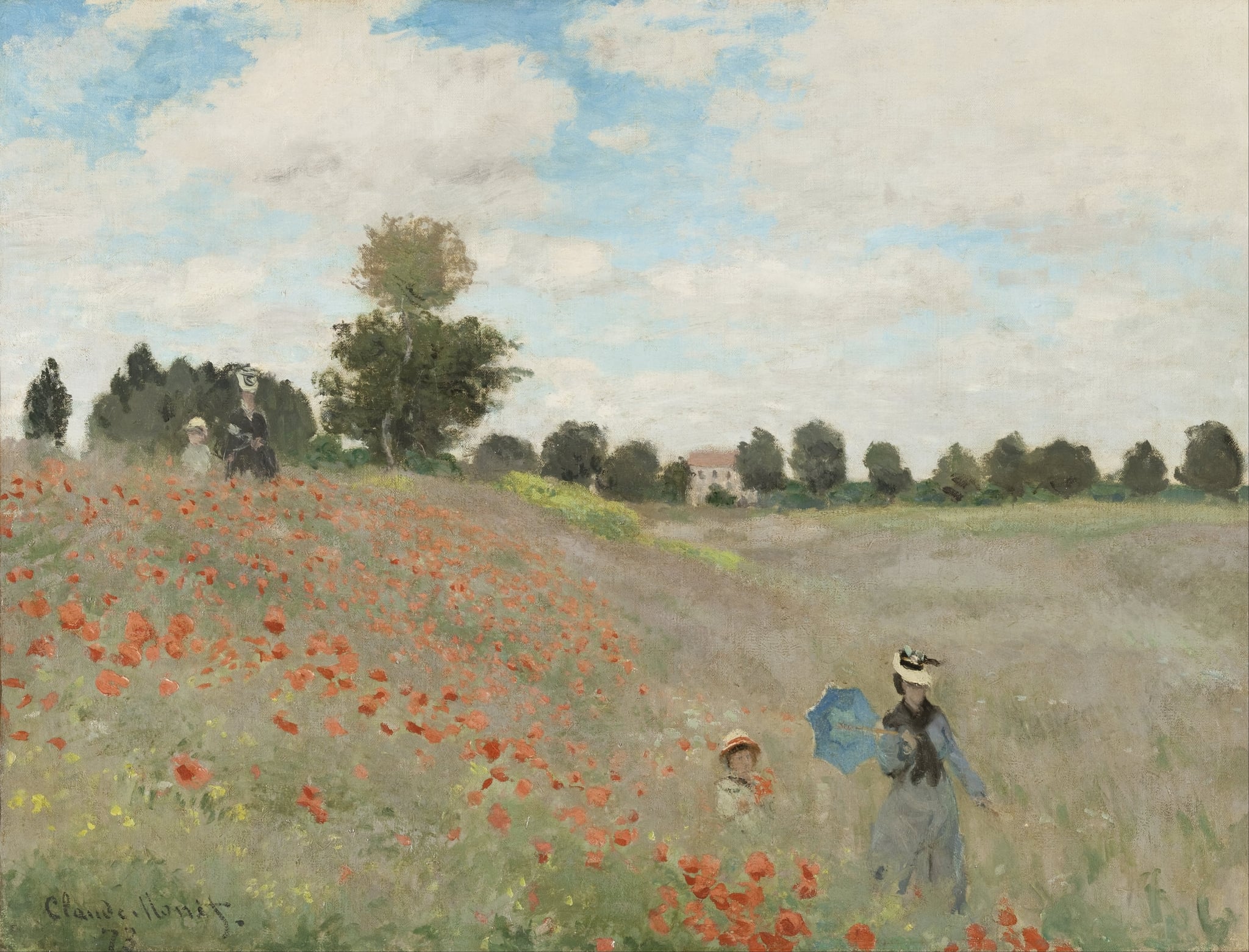
Poppies
Claude Monet (1873)
Claude Monet’s Poppies (1873) turns a suburban hillside into a theater of <strong>light, time, and modern leisure</strong>. A red diagonal of poppies counters cool fields and sky, while a woman with a <strong>blue parasol</strong> and a child appear twice along the slope, staging a gentle <strong>echo of moments</strong> rather than a single event <sup>[1]</sup>. The painting asserts sensation over contour, letting broken touches make the day itself the subject.